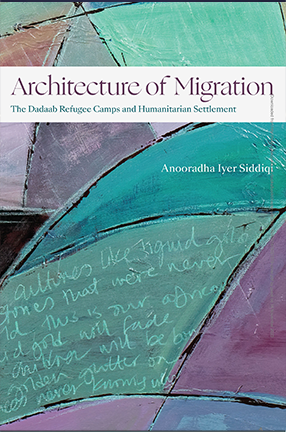A Refugee Camp is a Complex Web of History, Architecture, and Politics
Anooradha Iyer Siddiqi’s book, Architecture of Migration, asks readers to reconsider the Dadaab refugee camps in Africa through a new lens.
Environments associated with migration are often seen as provisional, lacking both history and architecture. As Anooradha Iyer Siddiqi, an architecture professor at Barnard, demonstrates in Architecture of Migration: The Dadaab Refugee Camps and Humanitarian Settlement, a refugee camp’s aesthetic and material landscapes—even if born out of emergency—reveal histories, futures, politics, and more. She identifies forces of colonial and humanitarian settlement, tracing spatial and racial politics in the Dadaab refugee camps, which were established in 1991 on the Kenya-Somalia border.
The dense Dadaab camps manifest decades of architectural, planning, and design initiatives, and a much older constructed environment. Siddiqi moves beyond ahistorical representations of camps and their inhabitants by creating a material and visual archive of Dadaab, finding long migratory traditions in the architecture, spatial practices, landscapes, and iconography of refugees and humanitarians. Countering concepts of refugee camps as sites of border transgression, criminality, and placelessness, Siddiqi instead theorizes them as complex settlements, produced through histories of partition, sedentarization, domesticity, and migration.
Siddiqi discusses the book with Columbia News, along with what she read while researching the book, what she plans to read this summer, and what she’s working on now.
Why did you write this book?
Architecture of Migration is a call to go slowly, and to look closely at forms and spaces that we may think we understand because we are inured to visually consuming certain kinds of images. Through quietly examining the architectural forms, spatial practices, and historical geographies of the Dadaab refugee camps, I ask us to reconsider how we unwittingly assimilate violence, especially in the militarized modes by which we receive and construct knowledge. A refugee camp is a spatial response to armed conflict, indeed. However, we often find ourselves glossing over the larger forces that normalize armed conflict, which either cast the camp as the abject remnant of war that people have somehow brought upon themselves, or dismiss it as lacking aesthetic and historical significance.
This book instead asks us to normalize the work of people—to live their lives, build their homes, farm for provisioning, and create domestic security, comfort, and joy—in a camp. The book invites us to defamiliarize spaces that we think we know through generic photographs, and to see them anew as living archives of the most extreme inhabitations of our shared world.

What books did you read for research, and what's next on your reading list?
For Architecture of Migration, I drew on close readings of many works. The book begins by asking what we learn when we look closely at a refugee camp. My response is that a refugee camp is the architectural afterlife of partitions. To understand this better, I turned to The Long Partition and the Making of Modern South Asia by Vazira Fazila-Yacoobali Zamindar, who unpacks South Asia’s radical partitioning as more than a line drawn on a map in an instant in 1947. Instead, she shows that this division was the outcome of actions by governments, planners, agencies, and communities upon the urban fabrics of India and Pakistan—over many years, and in countless, ever-reproducing forms.
To understand the partitioning of the self that refugees undergo in the process of being recognized as such, I read Casualties of Care: Immigration and the Politics of Humanitarianism in France by Miriam Ticktin. She follows the lives of asylum seekers and the bodily imprints of the state as it imposes humanitarian care. The racialization of this experience and that of architecture broadly has been elucidated most vividly in the scholarship of Columbia GSAPP Professor Mabel O. Wilson, who, with Charles Davis II and Irene Cheng, edited the book Race and Modern Architecture: A Critical History From the Enlightenment to the Present.
At the core of Architecture of Migration is a study of the paradoxes of humanitarian settlement, especially in effecting the sedentarization of people born into long migratory traditions, who carry generations of knowledge about ecologies and architectures predicated upon migration. My work on settlement owes a debt to the research of one of my former professors, Felicity Scott, especially in her book, Outlaw Territories: Environments of Insecurity/Architectures of Counterinsurgency. Finally, my book was also impacted by Esra Akcan’s empirical methods and historiographical re-readings in Open Architecture: Migration, Citizenship, and the Urban Renewal of Berlin-Kreuzberg by IBA 1984/87, which revises our understandings of architecture and history.
In the coming weeks, I am excited to read recent books such as Kathryn Yusoff’s Geologic Life: Inhuman Intimacies and the Geophysics of Race, Poulomi Saha’s An Empire of Touch: Women’s Political Labor and the Fabrication of East Bengal, Samia Henni’s Colonial Toxicity: Rehearsing French Radioactive Architecture and Landscape in the Sahara, and How Secular Is Art? On the Politics of Art, History, and Religion in South Asia, edited by Vazira Zamindar and Tapati Guha-Thakurta.
What are you working on now?
I am completing a book manuscript, Ecologies of the Past: The Inhabitations and Designs of Anil and Minnette de Silva. The book historically contextualizes the work of architect Minnette de Silva, one of the first women in the world to establish a professional architectural practice as sole principal (in Ceylon, in 1947), and art historian Anil de Silva-Vigier. She organized a 1950s documentary team that visited the Duanhang caves, where Buddhism is believed to have emerged in a China that was, at that time, closed to travelers from the West, and was editor of the UNESCO series, Man Through His Art.
The work and intellectual careers of these significant Sri Lankan cultural figures activated global art and architectural modernism through an attentiveness to land-based material practices of horticultural cultivation and craft production in South Asia. Through these land-based design interventions and writings on ecologies of the past, they critically addressed the politics of heritage environments.
What are you teaching in the fall semester?
I teach courses that tie into my broader interests in colonialism and postcolonialism, heritage politics, historicity and archives, migration and abolition, social justice, and diverse forms of aesthetic practice and cultural production. My courses in 2023-24 and 2024-25 include Life Beyond Emergency: Ecologies and Inhabitations of Migration; Abolition Architecture; Histories of Architecture and Feminism; Modern Architecture of South Asia; Partitions, Borders, Camps; and Colonial Practices.
